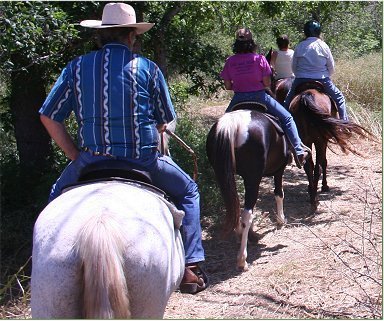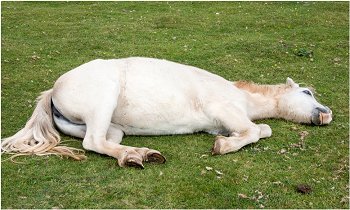 I got this email from a friend at the ranch yesterday. I had not heard of this condition as an actual pathology and thought it is worth a page of deeper explanation. (How lucky I am to have so many different horses to learn from. The ranch is like Horse Speed-learning for Dummies)
I got this email from a friend at the ranch yesterday. I had not heard of this condition as an actual pathology and thought it is worth a page of deeper explanation. (How lucky I am to have so many different horses to learn from. The ranch is like Horse Speed-learning for Dummies)
My friend Jan says, “My pony overheated yesterday. The strange thing is that it was cooler yesterday morning than it has been. I had ridden Winter very lightly in the woods. Mostly walk. Some trot. A little canter. No arena work.
The first clue was that she would not eat her lunch or treats. I turned her out to graze. She immediately went into her paddock and COLLAPSED. I thought she was dead. Her legs were out stiff. But when I got to her, there were gut sounds, so I did not worry about colic. I managed to get her up and hosed her down some more before I put her away. Then I had to leave. Chuck gave her a new salt block. Lucia checked on her in the afternoon. Charlie and I went out to see her last night. She seems to be recovered.
This happened once last summer too.
My pony seems to be ok now, but she is not sweating. I am going to start her on a supplement for anhydrosis.
Interesting. When we moved to TX, the vet cautioned me that horses that move from cold climates to hot climates often develop anhydrosis. Since it did not happen right away, I had thought I did not have to be concerned. (She moved here at least 5 years ago) I guess the key word was ‘develop’.
Lots of causes. Some breeds are more pre-disposed to it. TB horses in particular (you know she is half TB). I looked on the internet and some people have noted hair loss on the face as one of the outward signs. I had recently noticed facial hair loss on Winter and wondered vaguely what was causing it.
Susan and I are going to take an easy hack tomorrow; Spend some time in the river. If you are out, I will see you when we get back.”
 It is July 1 as I write this. July in Texas is something many people try to escape. The temperature has been hovering between 93 and 101 for days with just hours of relief each week if we get one SMALL rain storm passing through.
It is July 1 as I write this. July in Texas is something many people try to escape. The temperature has been hovering between 93 and 101 for days with just hours of relief each week if we get one SMALL rain storm passing through.
The humidity is like a pressure cooker. I noticed yesterday, as I mowed a pasture (93 degrees + humidity), that the horses in it had sweat dripping down their haunches just doing nothing. It didn’t seem to bother them that the day was so hot. They have a shelter where they can stand in the shade. But they preferred to be wandering around, grazing, and trying to see what I was doing on the riding lawn mower. One of the ponies stretched out flat on the ground and took a nap in the full sweltering sun.
While there seems to be little consensus or understanding of Anhidrosis in horses, and while the internet may not need one more over-simplified discussion of the subject when more educated opinions are available, in an effort to make this site as comprehensive as possible for a novice reader, I humbly present this information.

Signs of Anhidrosis: Anhidrosis can come on suddenly (as it did in Winter’s case). When my normal horse goes on a slow trail ride in this abominable heat, she comes back with sweat dripping down her face, shoulders, under her saddle, haunches. She has a broad pattern of sweating. Winter, on the other hand, came back from her ride with nearly no moisture on her skin: hardly even any under the saddle. Horses suffering this condition become lethargic, lose appetite, perform poorly, breathe much more heavily and for longer periods of time after mild exertion, and often feel dry and hot to the touch after working instead of sweaty.
Sweat, is, of course, a way to produce evaporative cooling, bringing heat from the working muscles to the surface to be dissipated, leaving the horse cooler. Hard breathing can cool as much as 25% of the internal heat, but evaporative cooling at the surface of the skin is the most effective cooling process.
It is thought to take about 30 minutes for a normal, sweating horse to lower its body temperature to normal after exercise.
Causes of Anhidrosis: Many researchers have posited that it might be a thyroid problem, but others have debunked the theory and caution against thyroid supplementation as it can lead to other major problems. Some feel strongly that it is inherited – not yet proven but a possibility. Many feel it has something to do with the neurotransmitters to or from the sweat glands. I wonder if it happens in older horses more frequently than younger ones. Perhaps one of our readers has some experience with it in that regard.
Management of Horses with Anhidrosis:

Betta Breuhaus, DVM, PhD, an associate professor of equine medicine at North Carolina State University’s veterinary school, has devoted her time to researching equine anhidrosis.
Breuhaus’ observations are telling: “If an anhidrotic horse is forced to continue to work in a hot, humid climate, he will eventually become overheated and unable to continue. If rectal temperature rises much over 104°F, the horse may collapse.”
Breuhaus stresses a comprehensive management approach. “Try to keep the horses cool (with misting fans, air conditioning, water soaks, etc.); stop working the horse for several weeks; reduce any other stresses; look for and treat any underlying diseases such as small airway inflammatory disease, equine Cushing’s disease, or any other illness; and supplement with electrolytes,” she recommends. “Body clip in the autumn or if the horse is beginning to grow a longer coat.”
 Medications? Jan’s horse, Winter, will try a medication called One AC. While there is no real research on its efficacy, there seem to be no contraindications either. Jan has also already done the obvious. She has made sure that the salt block in Winter’s paddock is good. She has added beet pulp with electrolytes to her diet (though Winter doesn’t seem to like the mixture much). She is going to try the “Guiness Beer” cure: A Guiness a day. Jan’s rationale: as long as it doesn’t hurt, why not? If Winter doesn’t like it or shows no positive response, “we will all have a party”.
Medications? Jan’s horse, Winter, will try a medication called One AC. While there is no real research on its efficacy, there seem to be no contraindications either. Jan has also already done the obvious. She has made sure that the salt block in Winter’s paddock is good. She has added beet pulp with electrolytes to her diet (though Winter doesn’t seem to like the mixture much). She is going to try the “Guiness Beer” cure: A Guiness a day. Jan’s rationale: as long as it doesn’t hurt, why not? If Winter doesn’t like it or shows no positive response, “we will all have a party”.
At this point, Jan rides (walk only) in the early morning and includes a lot of time in the creek. She is now bathing her horse longer as a cooling exercise (rather than just to “rinse the sweat off”) after her ride. She carries a mister with alcohol if she sees signs of heat stress.
The good news for Winter is that she has not had this problem very long as far as we can tell. Her sweat glands may not have actually atrophied She is in otherwise very good condition, and careful management might see her get better.
The bad news for Winter is that some horses who develop this condition cannot be managed, or at least cannot perform in the warm months of the year. They must be ridden sparingly in cooler months only, retired, or sent north where the climate is less conducive to heat stress.
* Much of the cited research has been done by Jeremy Hubert, BVSc, MS, who is an Equine Surgeon Certified Specialist and an assistant professor of veterinary surgery in the department of veterinary clinical sciences at Louisiana State University, where the hot, humid climate of the Gulf Coast states often presents a challenge to athletic horses.
This is a very good article from which much of this simplified information was taken.
Please note that this advice is neither veterinary nor prescriptive in nature but offered only as an introduction to this topic.
We need your help. We certainly don’t know everything. Please share your expertise and experiences. Comment on what is already written or Suggest a Category and Educate us about it. Grow Horse-Pros.com©